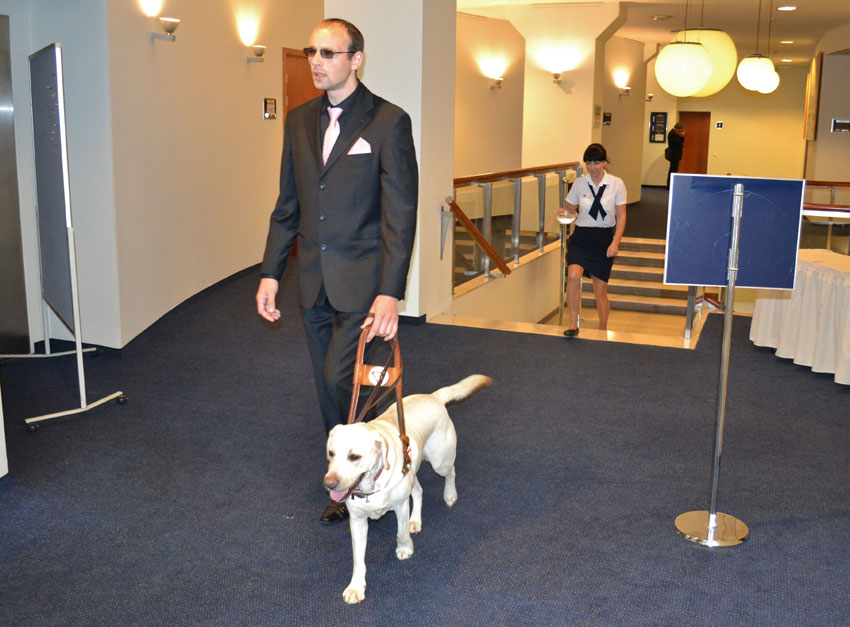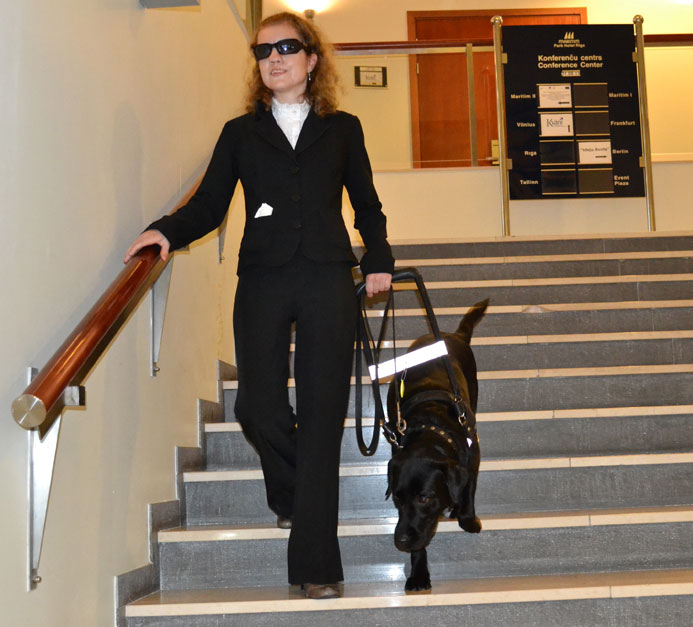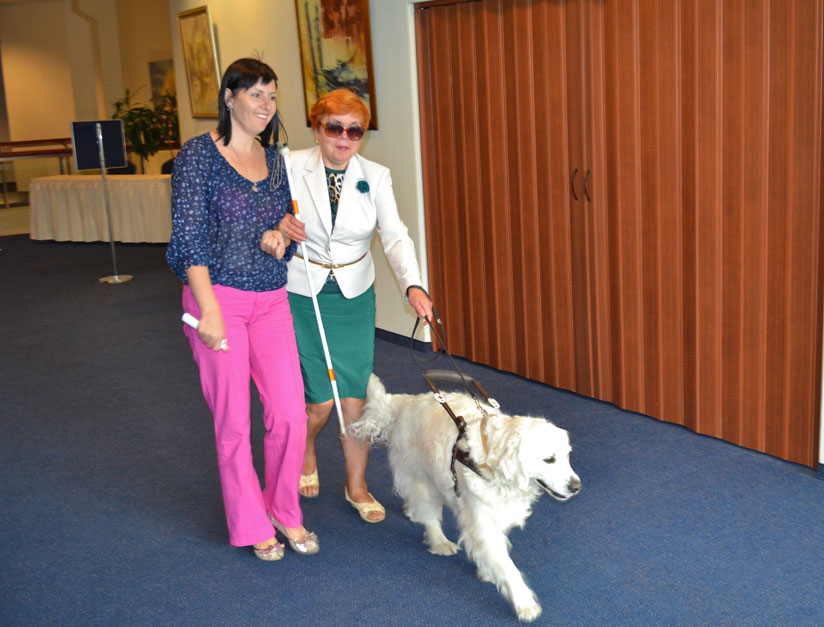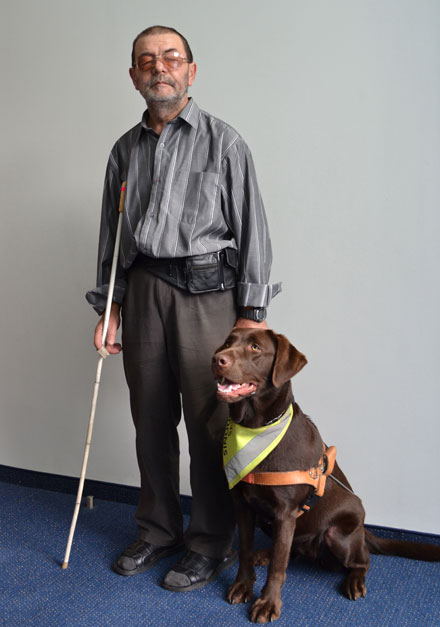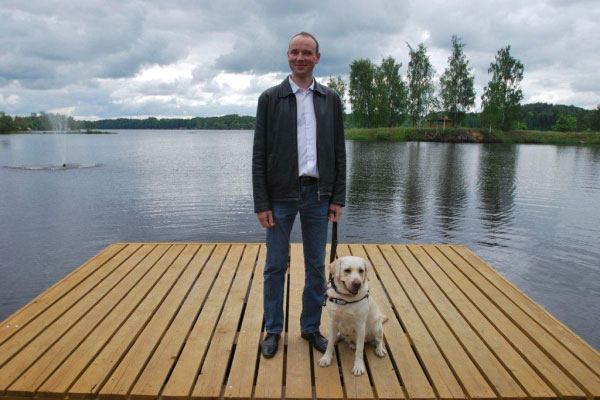History
Dogs have been man’s best friend since time immemorial. It is not known exactly when the dog was first used as a companion for blind people. A medieval woodcut has survived, showing a blind man following a dog on a lead. It is not known whether this technique was common in those days.
The first attempts to train guide dogs were already made around 1780 at “Les Quinze-Vingts”, an asylum for the blind in Paris. Then, in 1819, Johann Wilhelm Klein, founder of the Vienna Institute for the Blind, published a book on the education of blind people, also mentioning the methods of training guide dogs. Unfortunately, this idea did not catch on at the time.
Almost a hundred years have passed. During the First World War, dogs also served in the army – helping to find wounded soldiers, delivering medicine and messages, pulling gun carts. Many young soldiers lost their eyesight during poison gas attacks, which in turn led to public interest in the use of assistance dogs.
In 1916, the German doctor Gerhard Stelling opened the first guide dog school in Oldenburg under the name “German Shepherd”. It had branches in several German cities, training up to 600 dogs a year. The dogs were not only given to ex-soldiers, but later some were also given to the blind in other countries – Britain, Spain, France, Italy, the USA, Canada and even Russia. The school existed until 1926. Guide dog training was started internationally by a wealthy American woman, Dorothy Harrison Just. After learning German dog training methods, she founded her own school in Switzerland in 1928, and then in the USA, calling it “The Seeing Eye”.
Inspired by her success, she invited representatives from Germany, the UK and the USA to learn by becoming trainers of assistance dogs. Between 1930 and 1932, they returned to their home countries and started guide dog schools, spreading the idea worldwide and launching the International Guide Dog Movement.
Tutorial
Large dog schools have their own kennels. Puppies are taken from bitches owned by registered breeders with good pedigrees and calm temperaments to encourage inheritance of the best traits and avoid hereditary diseases. Both dogs and bitches are used as companions. Puppies are weaned at around 6-8 weeks of age, checked for health (hearing, sight, smell, etc.) and vaccinated. The puppies are also tested for their suitability for the new job – the future companion should not be nervous, fearful, aggressive, but eager to work and have good concentration skills. Another test/selection takes place later, at the start of training.
The first year of life is usually spent with a family, taking part in the so-called Puppy Walking Programme. Puppies’ temporary owners take them to the shops, on public transport and walk them around town, teaching them to walk on a lead and obey a few simple commands. During this time, the puppy grows, develops its senses and learns to live with people.
Although the training system varies from country to country, most training starts at around one year of age. In a guide dog school, intensive training takes place under the guidance of a trainer for 4-6 months. After that, they spend about a month at the school with their future owner. At the dog school, the dog learns to walk in a straight line down the middle of the pavement, to avoid obstacles, not to turn around corners without a command, to stop at the side of the pavement and wait for a command to cross, to navigate traffic, not to get into conflicts with grumpy littermates, etc. Dogs are good at detecting width – e.g. the sidewalk – to avoid obstacles and people. They have more difficulty with height, but guide dogs are also trained to spot and avoid distracting objects at head height.
No matter how clever and trained the four-legged companion, everything is determined by man. That’s why virtually all assistance dog training organisations offer their clients various courses to improve orientation and mobility skills. They teach how to walk with a white cane, how to use residual vision, etc., because a guide dog is only a good tool, not a magician who fulfils the owner’s every wish. For example, when approaching a ladder, a small pothole or other obstacle, the dog will stop while the owner uses the white stick to identify the problem and what to do.
To cross the street, a blind person is taught to determine the volume of traffic by sound (dogs, unfortunately, do not distinguish colours, so they cannot navigate traffic lights). When the human thinks the street is empty or the cars have stopped at a red light, the dog is given the command “Forward!”. However, the dog has the right to refuse to obey this command if it sees a car approaching or if a cyclist suddenly pops around the corner, unheard by the owner. As soon as the way is clear, the dog will go forward without being ordered again (this animal skill is called “reasonable disobedience”).
Even after graduation, the connection between the owner and the assistance dog and the former training institution is not lost. Further training is provided on a regular basis (especially taking into account the needs of the specific environment, learning local routes), and at least once or twice a year an instructor visits the client at home. In some countries, guide dog training is funded by the state, but in most cases it is an initiative of private or public organisations. In Australia, for example, the Guide Dog Association is a public organisation whose budget is made up entirely of donations from sponsoring organisations and individuals; training and receiving a guide dog is free of charge for visually impaired people.
Facts
There is no maximum age limit for a guide dog (the minimum age is usually between 16 and 18 years). The physical condition of the person and his/her needs are the determining factors. A dog is available to a visually impaired person in Group 1. The main thing is that the person has a real need to use the dog as a companion (not just as a friend), has good orientation skills, is able to take a leading role in the dog-human relationship, and can provide the dog with suitable living conditions – feeding and medical care, in accordance with Cabinet Regulation No 266.
It is important to assess the dog’s character and qualities, as well as the owner’s lifestyle and needs. Finding the most suitable and compatible dog for each visually impaired person (even taking into account height and stride length!), even if this means that in some cases the client has to wait longer for the right dog. It is very rare that a dog has to change owners later because of incompatibility.
When walking with a blind owner, the dog is put on a special collar with a handle, something like a harness, and the dog knows that when the bridle is put on, the serious work begins. When the special collar is removed, the dog behaves like a normal family pet. People around the dog should also remember that a dog wearing a harness should not be petted, fed, spoken to or otherwise distracted. The dog is at that moment doing its duty with great responsibility and the safety of its blind owner depends to a large extent on its ability to concentrate (you wouldn’t think of suddenly jerking the steering wheel when sitting next to the driver of a car, would you?).
Assistance dogs are not restricted from public places – they can go with their owner on public transport, fly (they do not have to be quarantined when they arrive in another country), go to their owner’s workplace, go shopping, attend social events, stay in a hotel, go to restaurants. The owner does not have to worry about the dog disturbing other people, as it is trained to sleep peacefully under the owner’s chair or in a designated area. However, this legal right is not always respected.
On average, guide dogs last 7-10 years, then retire for a well-deserved rest. As in the Puppy Walking Programme, many families wait in line to get their hands on a calm and collected, very friendly and loving four-legged retiree with an outstanding past. Often the dogs also stay as family pets with the previous owner, their friends or relatives.

